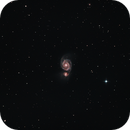Alright I went through a painful exploration on the things above about ISO and dynamic range, so I want to answer the questions I posed above and leave it at that since it's slightly tangential to the original topic, but I still don't want to leave the details unaddressed for future readers of this thread.
My main questions on my reply directly above were because we didn't distinguish between
sensor DR and
image DR. Sure, if your image didn't have
any clipping on the top end at a certain ISO, and bumping it up still left no clipping, then the
image dynamic range didn't decrease. But your capacity to measure higher photons with distinction did (the
sensor's capacity). However, it's rare in practice to have no clipping in the brighter stars upon doing this, so to give the best results in all general cases, one should increase the ISO past the downstream noise levels and go no farther, which is determined by the individual camera's "sensor dynamic range" vs. "ISO" graph (see the link that was posted above).
Although in theory you wouldn't lose
image dynamic range by increasing the ISO if absolutely nothing became clipped, it's probably not worth the risk and the benefits are fairly small at that point once the downstream noise has been overwhelmed by the signal.
As it pertains to OP, ISO500 is well above his camera's "ISOless" value (although many need 800 or 1600, the D7000 is exceptionally low on noise- see link above) so he probably would get no benefit by increasing it farther unless the histogram still doesn't have any white pixels after doing so, which is hardly worth the risk.
Number one benefit is to use careful masks to pull detail out. Keep it up!


